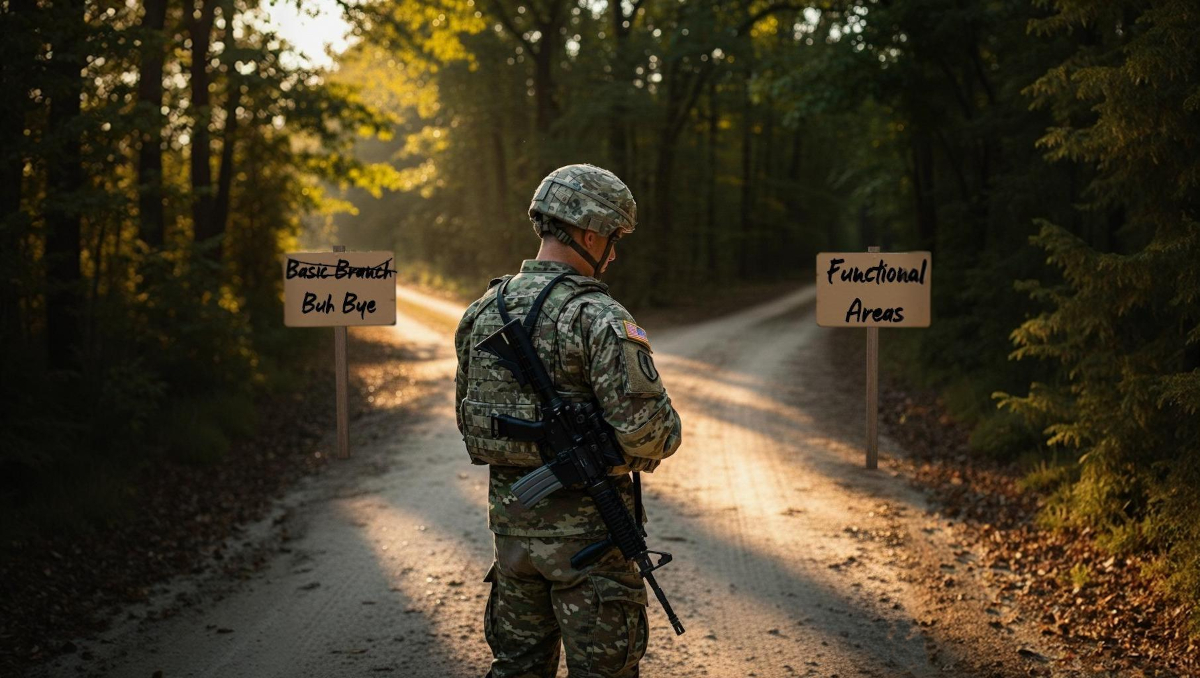
In fact, this article shows that the core tension isn’t between basic branches and functional areas, but between functional areas and leaving the Army.
The contemporary U.S. Army faces significant challenges in retaining high-quality officer talent. Studies indicate that only 47% of company-grade officers continue service beyond their initial active-duty service obligation), with particularly acute losses among West Point graduates and ROTC scholarship recipients—precisely those officers in whom the army has invested most heavily. The reserve components have long had a retention crisis, particularly for command billets. The retention crisis has prompted re-examination of the factors driving talented officers to pursue civilian careers, compensation differentials, limited career autonomy, family strain, and misalignment between individual talents and organizational assignments frequently cited as primary concerns.
Against this backdrop, critics have raised concerns about the Army’s functional area specialization program. Some, like David Barno have suggested it creates “brain drain” from basic combat arms branches like infantry, armor, and field artillery with the best officers from basic branches. Others like R.D. Hooker Jr. suggest that officers who go to functional areas are marginal performers, those who want to avoid the “hard” jobs in combat arms to coast with minimal effort, or both. These opposing viewpoints are asserted without empirical evidence. This article tests both assertions. Recent pilot surveys suggest that rather than depleting talent or providing safe haven for “quiet quitters,” functional areas serve as a critical retention mechanism that preserves institutional knowledge and maintains the army’s competitive advantage for both the service at large and for the basic branches. In fact, this article shows that the core tension isn’t between basic branches and functional areas, but between functional areas and leaving the Army.
OPMS and the Origin of Functional Areas
While the army’s branches have been evolving and changing with the character of war, the introduction of functional areas represented a significant departure from most previous evolutions. In the late 1990s, the army created and redefined functional areas under OPMS XXI to reform officer management for the 21st century. Previously, officers held dual specialties: their basic branch and a functional area designation. In theory, this was a way to ensure sufficient density of basic branch officers, while allowing officers to gain depth in particular niches.
Yet the OPMS XXI Task Force found that in practice dual-track approach (branch + FA) wasn’t delivering depth: “the current dual-track system is producing relatively few officers with true functional area expertise and experience.” The dual-track system not only failed to provide officers with depth in their functional areas, but the Task Force was also concerned that officers’ tactical proficiency was suffering. The Task Force noted that field-grade officers’ time in key developmental positions was shortened, and many were spending the preponderance of their field-grade years outside of their basic branch. In fact, about two-thirds of combat arms field-grade officers were serving outside their branch at any given time.
Twenty years later, in a study of the effects of OPMS XXI, Susan Bryant and Heidi Urben found evidence that OPMS XXI likely had a positive impact on retaining certain officer cohorts. Functional areas effectively acted as retention valves, keeping talented but non-traditional officers, many with advanced degrees and academic experience, in uniform when they might otherwise have exited.
The Retention Challenge: Understanding Officer Career Decisions
Recent research reveals that officer retention decisions are driven by factors fundamentally different than previous generations. Today’s officer corps consists predominantly of dual-career families, with well over 60% of military spouses employed or actively seeking employment. Most workers in the generations available for military service (18 years to around 45 years old) believe that dual incomes are essential for financial security. This demographic shift causes the “PCS Penalty,” where frequent relocations impose substantial financial and career costs on military families, potentially reducing lifetime earnings by $400,000 to $1.2 million.
Beyond these family considerations, research indicates that retention is fundamentally linked to three core psychological needs: autonomy, competence, and relatedness. Officers who experience control over their professional development, opportunities to excel in their areas of expertise, and meaningful connections to their work demonstrate significantly higher retention rates across all career fields. These findings align with Self-Determination Theory, which posits that satisfaction of these basic psychological needs is essential for sustained motivation and organizational commitment.
Current officer timelines often miss these three components. They often lack autonomy as officers have few opportunities to change career fields after their pre-commissioning branch selection. Competence, which refers to feeling opportunities to build one’s skills in line with interests, is missing for officers whose basic branch’s core competencies lie outside of their interests. Misalignment can occur over time; an officer may be well-suited for junior tactical roles as an Infantry Platoon Leader, but lack the organizational acumen to lead a 700+ soldier Infantry Battalion. An officer’s skills and interests may change just as the skills and talent required at Lieutenant and Colonel ranks are different. A comprehensive RAND study of army talent management found that misalignment between individual talents and job requirements contributes significantly to officer dissatisfaction and voluntary separation. Relatedness, or the feeling of connection between an officer’s efforts and the larger mission, is often missing as officers in tactical formations feel like cogs in a wheel rather than captains at the helm. Army War College research connected the tenets of self-determination theory and officer retention that “effective talent management reinforces and links officer development, retention, and accessions programs” and that “assigning officers to positions leveraging their innate and acquired competencies can directly improve officer career satisfaction and success.”
Understanding the “Brain Drain” and “Quiet Quitting”
The most significant criticism of this model of officer talent management is a concern that functional areas siphon away top talent from basic branches. If true, this would be a huge concern. If the best and smartest officers left their basic branch, particularly combat arms branches, to play with applied mathematics (like FA49- ORSAs) or set up imaginary combat (like FA57s – Simulations Officers), then the Army would be like the cliche warning against having an army in which the fighting is done by fools and the thinking by cowards.
Taking an opposite tack, other critics claim that officers who switch to functional areas do so to escape the hard work emblematic of combat arms service. These critics believe that officers who switch to functional areas are content with doing the bare minimum; they claim officers are “quiet quitting” in functional areas.
The critiques rest on two fundamental assumptions that are very different. The first critique rests on the testable assumption that functional area officers really are the best officers from their respective basic branches. The second critique can be tested by seeing if functional area officers’ career outcomes are changed after transitioning to a functional area. And last, the OPMS XXI assertion that the voluntary transfers to a functional area serve as a retention mechanism can be tested through a new pilot survey of functional area officers.
Empirical Evidence: Functional Area Performance
As for the first assumption, the evidence shows that functional area officers are not universally top performers in their basic branch. The RAND research looking at the voluntary transfer incentive program for functional areas showed that for the researched period of 2012-2019, “functional areas struggled to attract officers who meet the army’s quality threshold on military performance,” and “officers with low performance disproportionately apply for transfer to a functional area.” However, it should be noted that the quality of applicants actually selected varies greatly depending on the functional area, with some having more rigorous accession criteria than others. This finding undercuts the “brain drain” argument.
Quantitative analysis of promotion and retention data revealed that functional areas consistently outperform Army averages in officer retention metrics.
The second assumption would accept the above empirical findings, but also assume that these “quiet quitting” officers would continue to underperform. However, this same RAND study found different results when looking at post-transfer promotion rates. Quantitative analysis of promotion and retention data revealed that functional areas consistently outperform Army averages in officer retention metrics. Examining promotion rates from the same time period, the author found that multiple functional areas exceeded Army Competitive Category averages at both major and lieutenant colonel levels. Specifically, FAs 30, 29, 59, 50, 51, 48, 49, 34, and 52 exceeded average promotion rates to major, while FAs 47, 59, 34, 49, 51, 50, 48, 56, and 52 exceeded average promotion rates to lieutenant colonel. This suggests that switching from a basic branch officer to a specialization changed their performance. This could be due to a number of factors, including better talent/interest match, effective education/training qualification pipelines, or greater career autonomy.
Perhaps the starkest finding concerns the third assumption. Testing the OPMS assertion that functional areas serve as retention tools, we found significant support. In a short-run, pilot survey of army functional area officers, nearly two-thirds (62%) of functional area officers responded that if switching into a functional area were not an option, they would have either “absolutely” left service (24%) or “most likely would” have left service (38%). Write-in comments on the pilot survey also pointed to aspects of self-determination theory including autonomy (“Absolutely no interest in my basic branch career path. Overly restrictive and deeply uninteresting”), relatedness (“I’m allowed to engage in more meaningful work and projects with a larger impact”), and competence (“It allowed me to go to a specialty where my strengths are amplified rather than my weaknesses”). Many other comments explicitly referenced dissatisfaction with basic branches: “I didn’t choose my branch, the Army chose it for me,” and more colorful comments like, “I was [field artillery] because I screwed around at [leader development and assessment course] and a bunch of us got forced into being [field artillery]. And then I spend my time in Afghanistan being a second-rate infantryman, tagging along with a PL [platoon leader], but not actually getting to lead shit… If I could have left with any sort of savings, I would have… I was trapped and becoming a Sims officers [FA57] was the only way I could stay in the Army to retirement without wanting to take a toaster bath every night.” While this pilot would need to be expanded and include a better sample of functional area officers, it validated claims made by the 2017 Bryant & Urban study that functional areas are effective retention tools.
The Blended Retirement System: Structural Disincentives and the Need for Career Alternatives
Why be concerned about functional areas and officer retention now? Beyond debunking the claims of a combat arms “brain drain,” the army is in a critical window. The army’s transition from the traditional 20-year cliff-vesting pension to the Blended Retirement System (BRS) in 2018 has fundamentally altered the cost-benefit calculation for officer retention, inadvertently creating structural incentives that favor leaving the Army earlier. Under the legacy High-36 retirement system, officers who separated before completing 20 years of service received no retirement benefits, creating a powerful financial incentive to remain through the full career. The BRS, however, provides immediate vesting of government retirement contributions through the Thrift Savings Plan after just two years of service, with full portability upon separation. This reduction of opportunity costs for leaving at the 8-12 year mark (precisely the functional area transfer window) puts the army in a tough spot.
Here, the pilot study gives a peek into officers’ thinking. While 24% of functional area officers polled would have “absolutely” left the Army if transferring to a functional area was not available, when given the scenario of having a portable BRS retirement package (TSP-vesting), the number of respondents who would have “absolutely” left service doubled to 48% with an additional increase in total respondents who would have “absolutely” or “strongly considered” to 69%. This, again, requires further examination, but suggests that the choice is not between functional areas and basic branches, but between functional areas and leaving service; moreover, the maturation of the BRS may produce strong incentives for officers to leave. Without career flexibility, like changing into a functional area, officers who are dissatisfied with their basic branch will leave service entirely, representing a much worse brain drain.
Conclusion
The army’s functional areas represent a strategic investment in talent management that addresses contemporary retention challenges while building institutional capability. Rather than creating “brain drain” from basic branches, functional areas provide alternative career paths that retain officers. As the army continues evolving its talent management approach, functional areas should be viewed as a necessary relief valve to stem the tide of the “brain drain” to the civilian world. The changing talent landscape, especially officer demographics, generational desire for career autonomy, and empirical evidence, all argue for expanding rather than constraining officers’ career options. Functional area specialization provides a proven mechanism for achieving this objective while maintaining the army’s competitive advantage in an increasingly complex strategic environment.
Paul Kearney is an active-duty Army Strategist and GEN Andrew J Goodpaster Scholar completing his PhD at Duke University in Political Science. He holds degrees from the United States Military Academy, King’s College London, and Georgetown University.
Dennis Halleran is an active-duty Army strategist and GEN Andrew J. Goodpaster Scholar pursuing a PhD at the Schar School of Policy and Government at George Mason University. His previous assignments include U.S. Africa Command and the Joint Staff J7. He holds degrees from Villanova University and the University of Florida.
The views expressed in this article are those of the author and do not necessarily reflect those of the U.S. Army War College, the U.S. Army, or the Department of Defense.
Photo Credit: Generated by Gemini





Good article! I was a Functional Area officer- best decision I made in the Army. There is a (not so great) tendency for some in the Army (and those opining from their past experience) to assume everyone wants to follow the same career path (aka Command/operational). This tendency is then moderated by the reality that not everyone in a branch can command a battalion/brigade etc. So officers have to make some decisions- and family (working spouse, kids stability, workload, work environment etc. are factors (whether the institution wants to acknowledge it or not) As the Army gets smaller- the need to broaden the officer knowledge base will become increasingly necessary. Skills in AI, Robotics, Quantum etc. will be needed- and those wont be formations, but technology and skills that enable those formations. You should do a follow up on the feedback you get. Again- well done.
I was a base branch Signal Officer with a technical undergraduate degree. Time and time again, I saw many base branch Signal officers fail to understand the technology they managed for the warfighters, and relied on contractors who often didn’t know the technology either — they only knew it a little better than the officers. As a functional officer, I was able to apply my technical expertise to provide practical, functional solutions to the warfighter in the field across five deployments — in many cases far better than the contractor “experts” who deployed with the equipment. I would’ve been gone before 10 without the functional area option, and I ended up serving 27 instead, including moving back to operations as one of the founding officers of the Cyber Operations branch.
It seemed apparent to me that even in a combat situation, the combat arms were 90% tedium and 10% terror. The intelligence functional area was much more like the Pinkertons: We Never Sleep. As a child of the Cold War, military intelligence seemed like something to keep me engaged both on and off the clock.
As time went by, I got to apply my PhD professional training in Psychological Operations and so my career became half SOF and half MI, functional areas that nicely complimented each other.
All that said, the best Army Schools I attended were at the then Fort Benning School for Boys–Infantry Basic and Infantry Officer Basic. To this day I find that training useful.
For example, how to fall asleep instantly and then wake up instantly.
In any organization, proper career alignment can increase overall productivity and retention.